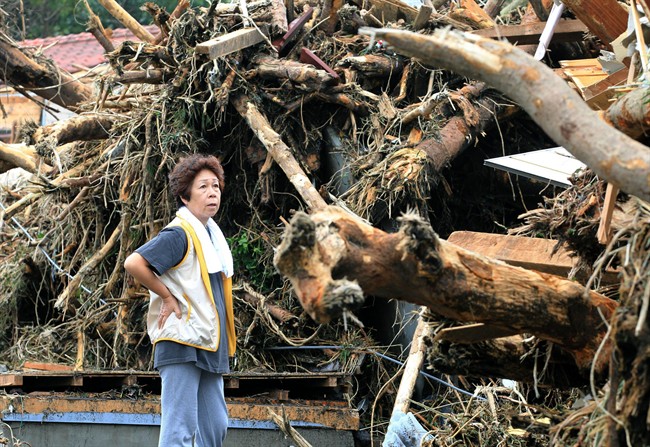TOKYO – The mayor of a Japanese island devastated by a deadly typhoon apologized Thursday for failing to issue an evacuation order, as rescue workers combed through mountains of debris searching for the missing.

Typhoon Wipha, which swept up Japan’s east coast on Wednesday, killed at least 22 people, and more than 30 others are missing, government officials said. Most of the victims were on the island of Izu Oshima, about 120 kilometres (75 miles) south of Tokyo.
“There is concern that perhaps more lives could have been saved if there had been an evacuation. We have concluded this and must apologize,” Mayor Masafumi Kawashima said at a news conference. “It’s my deepest regret and I will not forget this.”
About 1,100 rescuers were searching through huge piles of trees and destroyed homes swept downhill by mudslides, shouting in hopes of finding survivors. The search was hampered by the slippery mud.
Town officials had issued repeated warnings of river flooding early Wednesday morning, during the worst of the torrential downpour, but stopped short of ordering any areas evacuated.
Initially, Kawashima defended the decision, saying Wednesday night that he feared a middle-of-the-night evacuation under such harsh conditions would do more harm than good.
Disaster management minister Keiji Furuya told reporters that the central government was looking into the case and that he planned to send a team of experts to the island later this week to “investigate what exactly happened and why.”
The areas affected by the mudslides were indicated as hazardous zones on maps, he said, adding that the government was checking to see whether there was any factual basis for complaints that an evacuation order should have been issued.
The damage was almost exclusively concentrated in the town of Motomachi on the northwest corner of the island, which sits on slightly steeper ground.
“That caught us by surprise,” said a town official who spoke on condition of anonymity, citing the sensitivity of the issue. He added that the Motomachi area had survived past record-level storms. “So we hardly had any sense of crisis,” he said.
Izu Oshima is the largest island in the Izu chain. It has one of Japan’s most active volcanoes, Mount Mihara, and is a major base for growing camellias. About 8,200 people live on the island, which is accessible by ferry from Tokyo.
Yoshiharu Ishikawa, an expert of surface runoff at the Tokyo University of Agriculture and Technology, said he believed the top layer of volcanic ash from recent explosions had been washed off by the massive rainfall and quickly slid down on the solid bedrock of hardened lava, knocking down trees and washing down houses.
“It must have flowed down very fast,” Ishikawa told public broadcaster NHK on Thursday, as he inspected the disaster site. “Fallen trees added to the intensity of the mudslide, hitting the houses harder and washing them down.”
Kawashima, the mayor, was also under fire for being away during the crisis. He had to be airlifted home by a military helicopter from another island he was visiting for work, returning more than half a day later.
More than 350 homes were damaged or destroyed, including 283 on Izu Oshima, the Fire and Disaster Management Agency said.
—
Associated Press writer Elaine Kurtenbach contributed to this report.



Comments